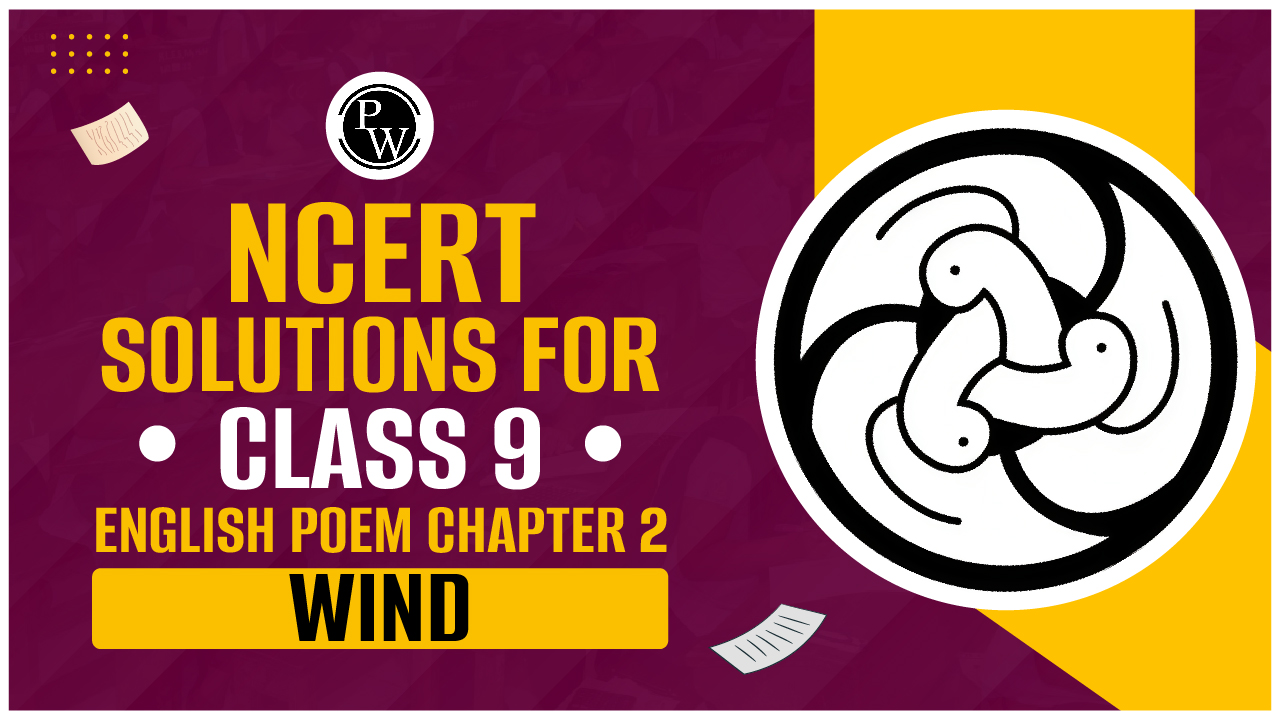NCERT Solutions Class 9 English Poem Chapter 2 Wind

Class 9 English Poem Chapter 2 Wind:- In the poem "Wind" from the Class 9 English curriculum, Subramania Bharati vividly describes the wind as a powerful and ever-changing force of nature. Through vivid imagery and figurative language, he portrays the wind as playful yet formidable, influencing the environment and affecting people's lives. The poem not only celebrates the beauty of nature but also prompts readers to think about themes like resilience and strength in facing life's challenges. Get the NCERT Solutions Class 9 English Poem Chapter 2 Wind from the below article.
NCERT Solutions Class 9 English Poem Chapter 2 Wind
Thinking about the poem
Que 1. What are the things the wind does in the first stanza?
Answer- In the opening stanza, the wind enters forcefully through doors and windows, creating a chaotic scene inside. It overturns papers, sending them swirling through the air, and knocks books off their shelves with a powerful gust. The force of the wind is such that it tears pages from the books, scattering them in its wake. Additionally, the wind brings with it rain, adding to the tumultuous and disruptive atmosphere described in the poem's initial lines. This vivid depiction sets the stage for the poem's exploration of the wind's unpredictable and sometimes destructive nature.
Check Out: NCERT Solutions Class 9 English Poem Chapter 1
Que 2. Have you seen anybody winnow grain at home or in a paddy field? What is the word in your language for winnowing? What do people use for winnowing? (Give the words in your language, if you know them.)
Answer- Yes, I have observed my grandmother and mother winnowing grains at home. This traditional practice is known by various names in Hindi such as Fatakna, Barsana, Jara, and others. Nowadays, people often use winnowing baskets for this purpose.
Que 3. What does the poet say about the wind god winnows?
Answer- In a literal sense, "winnow" means to separate grain from chaff by blowing air over it. However, in the poem, it is used metaphorically. The poet describes how the wind mocks vulnerability, causing houses, rafters, and even hearts to tremble. The wind symbolizes a force that overwhelms and destroys anything lacking strength or resilience.
Que 4. What should we do to make friends with the wind?
Answer- The poet advises us to construct sturdy houses with firmly fixed doors to befriend the wind. Additionally, he emphasizes the importance of cultivating strong bodies and resilient hearts.
Que 5. What do the last four lines of the poem mean to you?
Answer- The poem's final lines convey a powerful message about resilience: while the weak may be broken by external forces like the wind, the strong are strengthened by these very challenges. It suggests that embracing and confronting formidable forces can lead to personal growth and empowerment, emphasizing the importance of inner strength in overcoming adversity.
Check out: Class 9th Books
Que 6. How does the poet speak to the wind — in anger or with humor? You must also have seen or heard of the wind “crumbling lives”. What is your response to this? Is it like the poets?
Answer- The poet addresses the wind with a touch of irony and humour, aiming to depict it as a living entity that delights in teasing and testing the weaknesses of both objects and people. By personifying the wind in this way, he transforms it into a symbol of adversity and challenge. The poet's message is clear: in the face of life's difficulties, it is essential to be strong not only physically but also mentally.
He underscores the importance of resilience and fortitude, suggesting that by cultivating inner strength, individuals can effectively confront and overcome the obstacles presented by the wind—or any metaphorical representation of hardship—ultimately emerging stronger and more capable. Thus, through his portrayal of the wind, the poet encourages a mindset of perseverance and determination in navigating the challenges of life.
II. The poem you have just read is originally in Tamil. Do you know any such poems in your language?
Answer- Yes, I have read such a poem in my language as well, which is known as “Toofan”.
Class 9 English Poem Chapter 2 Wind Summary
The poem starts by describing the various forms and characteristics of wind. It is seen as a powerful force that can move clouds, shake houses, and scatter seeds. The poet marvels at how the wind can be gentle like a lover's touch or fierce like a storm, showing its versatility and strength.
The wind is portrayed as a symbol of freedom and vitality, bringing freshness and life to everything it touches. It is compared to a playful child, roaming freely and joyfully across the earth. The poet also likens the wind to a wild horse, untamed and full of energy.
Overall, "Wind" celebrates the beauty and dynamism of nature, highlighting the wind's role in shaping the world around us and emphasising its essential place in the natural order.
Check out: Class 9th Combo Set of 5 Books
Class 9 English Poem Chapter 2 Wind FAQs
Q1. Who is the poet of the poem "Wind"?
Ans. The poem "Wind" is written by Subramania Bharati, a renowned Tamil poet.
Q2. What is the central theme of the poem "Wind"?
Ans. The central theme of the poem revolves around the power and characteristics of the wind. It explores its various forms, its impact on the environment, and its metaphorical significance in representing freedom and vitality.
Q3. How does the poet describe the wind in the poem?
Ans. The poet describes the wind as a dynamic force that can be both gentle and fierce. It is compared to a playful child, a wild horse, and a powerful entity that moves through landscapes, affecting everything it touches.
Q4. What is the significance of the wind in the poem?
Ans. The wind symbolizes more than just a natural phenomenon; it represents resilience, change, and the unpredictability of life. It serves as a metaphor for challenges and obstacles that individuals face, urging them to cultivate inner strength and adaptability.
Q5. What literary devices are used in the poem "Wind"?
Ans. The poem employs imagery to vividly describe the wind's effects. Metaphors and personification are used to give the wind human-like qualities and to emphasize its impact on the environment and human emotions.










